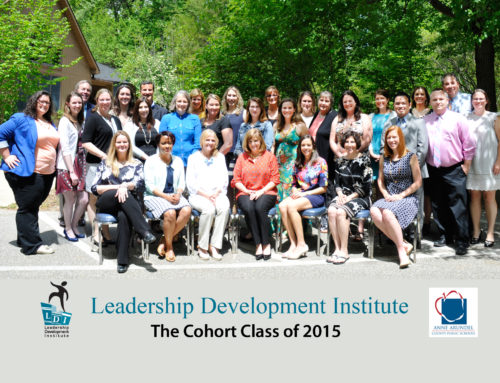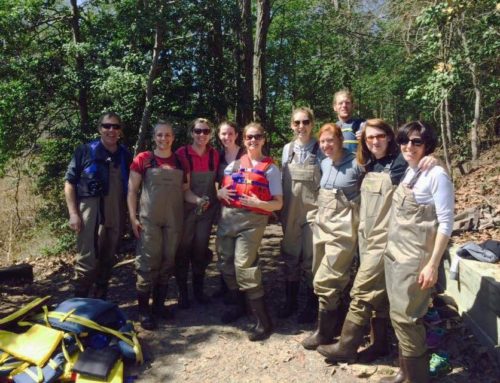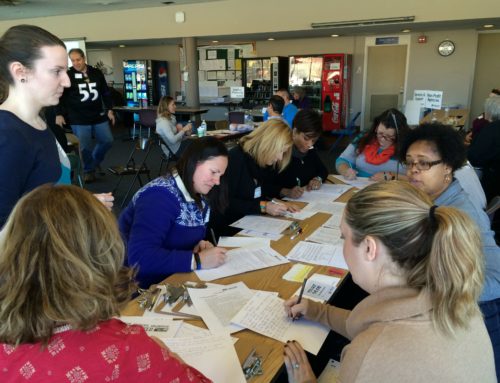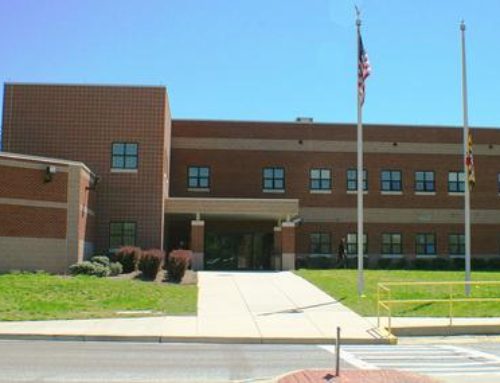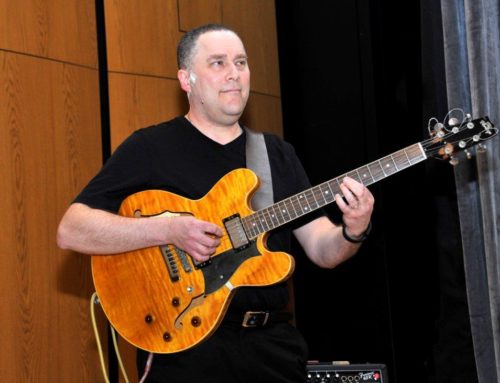Exploring Anne Arundel County’s business & economy
March 7, 2015
So far this year, we have had a lot of discussions around the impact of AACPS in our community. These conversations have involved key players across the county—from politics to justice, economics to social work—and have frequently focused around ways that we as educators can make a change in our office, classroom, or school to make our community stronger. This week we had the chance to speak with representatives from the Business Community and better understand our relationship as a two way street.
Meeting with the Chamber of Commerce

We were joined on Saturday morning by Mr. Bob Burdon and Mr. Rick Morgan. Mr. Bourdon, the CEO of Annapolis & Anne Arundel County Chamber of Commerce, gave us the lay of the business landscape in our county. Back in October, our class discussed the importance of Anne Arundel County’s tax base as the primary source of funding for our school system. Because of the residential tax cap, the county uses business taxes to supplement what cannot be raised through residential taxes. This is a difficult line to walk because while the taxes need to be high enough to support the public work occurring throughout the county, they also need to be low enough to make Anne Arundel County attractive to potential business owners. In October, this idea—that more businesses were better—was more or less accepted as a truth. But today Mr. Burdon asked us to think about why this was true. It turns out that this really revolves around that which has been argued and debated and fought over for centuries—land.
Of Anne Arundel County’s 400 square miles, approximately 1/3 of the land is devoted to public use with another 1/3 being used for agricultural purposes. This leaves 1/3 to be developed for the commercial and residential tax base. As we think about this developed land, it is important to consider the difference between the cost to provide services to a plot of land and the revenue that a plot could generate. If a contractor develops a single-family home, the cost to the county to provide public resources such as water, trach/recycling services, and emergency services (police, fire department, etc) will most likely be higher than the revenue generated from taxes. If a contractor instead chooses to build an office complex, the revenue generated from the future business will more likely outweigh the cost to provide services. This type of calculations helps explain one of the many ways that an increased business presence can help increase the county’s economy.
The Chamber of Commerce was created to bring businesses together; provide resources to its community; act as an advocate in public education, economic development, and shared environmental responsibility; and to be actively engaged in the community. Of the 13,000 businesses in Anne Arundel County, 86-88% employ less than 20 people and 46% of businesses employ less than 5 people. While small businesses have unique challenges, they, by nature, must stay closely connected to the region in which they operate. When working with the schools, this connection goes both ways. Just as it is important for businesses to understand the skills and backgrounds of their future workers, customers and tax payers, it is equally important for students to understand the economic sector that they will be entering after graduation.
Rick Morgan, currently a consultant, is the former CEO of Commerce 1st Bank, past member of the Federal Reserve Board, and former CEO of Anne Arundel Economic Development Corporation. From his perspective, one of the most important things we can help our students understand is the importance of interpersonal skills. From knowing how to conduct oneself during an interview to working in a professional office, teachers are now often responsible for teaching skills that used to be left up to parents.
It is also important to continue fostering partnerships with businesses to help students develop industry-relevant skills. By creating opportunities for students to experience the “real world” before they graduate, they can gain hands on experience in the fields that interests them. This, in turn, benefits both the industry and the student by developing a workforce that is ready for success.
Partnerships in AACPS
Focusing the conversation on ways in which AACPS is already developing partnerships with the business community, we met with Chuck Yocum, a graduate of the first LDI class and the Senior Manager for the Division of Partnerships, Development, and Marketing (PDM). Chuck helped the class understand the background behind this new division within AACPS and let us know about some of the initiatives that it is working to achieve. (Full disclosure, I also work for the Division of PDM, so I promise to do my best to not sound like a recruitment pitch).
The Division of PDM was established after former Interim Superintendent Mamie Perkins frequently commented on the lack of marketing within our county. While AACPS is doing awesome things, we struggle to sell ourselves to those outside the school building. So, the Development Office, which already had a connection with the business community through its work with the 21st Century Education Foundation, employee recognitions, and the employee discount program,was restructured in June. Now under the division of Academic and Strategic Initiatives, the mission of the Division of PDM became to develop partnerships that bring schools, families, and communities together to create opportunities and expand resources to provide access, equity, and excellence in education for all. In short, we are responsible for building system-wide partnerships, helping to develop grant opportunities, and promoting and celebrating the people and work within AACPS. Over the past eight months, we have continued to manage the responsibilities of the former Development Office (such as supporting grant applications throughout the county and working with Employee Recognition events like Teacher of the Year) developed spotlight initiatives like the Central Office Monthly Showcaseand the Behind the Scenes@AACPS Story Series.
Each of these opportunities highlights the commitment that AACPS has to develop opportunities to support schools and engage the community. This engagement is the first step towards providing our students with an education that is relevant to the 21st Century.
Developing our LDI Class Projects
Putting this commitment into action, we spent the second half of our LDI session further developing our LDI class projects. I know that I have pushed off talking about these projects for months, so now is the moment that you have all been waiting for: an explanation of the LDI project!
Designed to address a need within AACPS, the project is entirely self-directed and can take whatever shape we think appropriate based on the need. Working in self-formed groups, each LDI class is responsible for identifying real needs within the county and creating a solution. Some of the successful projects from previous LDI cohorts have included the creation of the Spanish AACPS website and Jake’s List, an online site to trade supplies from the Warehouse. Each group is responsible for putting together a business plan outlining their idea, creating a timeline for completion, and completing the project. Some projects are “one and done” and completed within the LDI course while others are ongoing and may extend beyond the end of LDI.
Since September, Griff has given us frequent opportunities to brainstorm and develop our ideas. Together we have thrown out a wide range of possibilities from energy conversation initiatives to an AACPS “Buddy Benches” program to a community app to connect families to local resources. Over time we narrowed the list down to five or six central needs and broke into organic groups around various goals—increasing employee knowledge of available AACPS programs, increasing engagement between new and seasoned teachers, providing increased resources to communities, etc. Currently, every project is still in development so I will not go into much detail about the great ideas being pursued by the class. But over the next two months, my group (Carla, Diana, Pat, Mike E, Laura, Lisa, Andrea, and Kim) will move forward with our project: Who’s Who & What’s What in AACPS, a video project to help new and existing employees better understand the programs and departments in AACPS. While not necessarily as exciting as some of the other student-based ideas, we hope that our project will help fill a need in the county that everyone in our project has personally felt.
Throughout the class there are some amazing ideas going and I’m excited to see the projects together over our last few LDI months.


